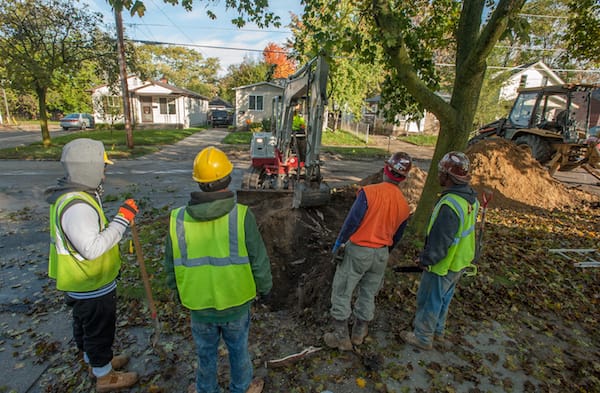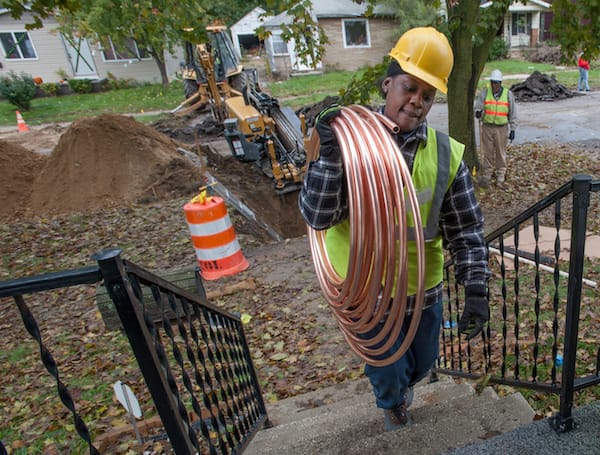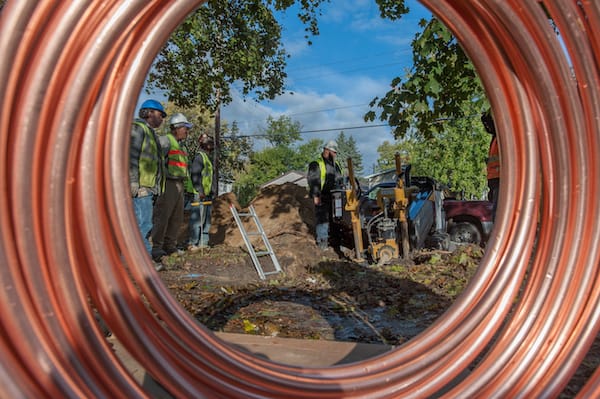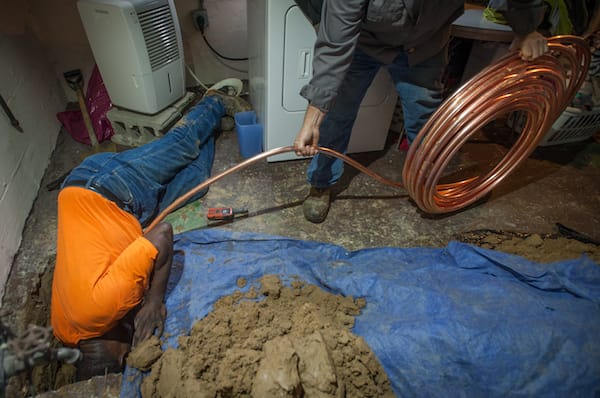# 1 – Learning New Regulations and Compliance# 2 – Developing Expertise# 3 – Getting Ahead of the Competition Lead pipe replacement is an issue. Between 1900 and 1950, cities in all 50 US states installed over 9 million lead water service lines which, in many cases, were mandated for benefits including their longevity. With Read more
infrastructure

Table of Contents
Lead pipe replacement is an issue. Between 1900 and 1950, cities in all 50 US states installed over 9 million lead water service lines which, in many cases, were mandated for benefits including their longevity. With most of these pipes lasting between 75 and 100 years, many are still in use today, despite the fact that we’re now fully aware of how risky high water lead levels can be.
At the end of 2024, Joe Biden proposed the ‘Lead Replacement scheme’, which aims to oversee the complete replacement of American lead piping systems in the next ten years. While there has been some concern about the viability of the ten-year timeline, states, cities, and water utilities all agree that plumbing infrastructure needs to change. The question is, what does Biden’s proposal mean for the plumbing professionals?
Ultimately, replacements of dangerous lead piping are good news, making jobs safer and ensuring better customer-facing results. But it would be naive to assume that a total infrastructure overhaul won’t bring any industry disruption. Luckily, plumbers can easily adapt to any upcoming changes with the following vital tips.
# 1 – Learning New Regulations and Compliance
Biden’s proposal shines a light on an industry problem that’s been causing significant health problems for years. We already know that high levels of lead exposure can lead to everything from developmental problems to cardiac arrest, and it’s certainly contributed to the health debt outlined by Alex Kleyner in this article. As water utilities take a step towards healthier processes, it’s more important than ever for plumbing professionals to stay on top of new regulations and compliance requirements for ongoing client safeguarding.
To handle lead pipe replacements, plumbing professionals particularly need to seek the correct accreditation, as well as specific pipe replacement certifications.
# 2 – Developing Expertise
While the extent and speed required for this mass replacement task might seem overwhelming, the replacement of lead piping also opens the door to requirements for brand new plumbing expertise. This is true in terms of replacements themselves, which not every plumber will be authorized to carry out, but there are plenty of other learning opportunities waiting within this change.
For instance, plumbers who are experienced in identifying lead piping will inevitably see an increase in business over the next decade. Equally, with most lead pipes being replaced by alternatives such as copper, iron, and steel, plumbers with experience in these materials will typically perform better.
# 3 – Getting Ahead of the Competition
Lead pipe replacements may bring new possibilities for industry business over the coming years, but they’ll also initiate a competitive rush to secure clients. As well as ensuring their accreditation and experience, plumbing professionals will need to find alternative ways to get ahead and come out on top in the new plumbing world, including offering competitive pricing, providing complete pipe replacement packages, and generally ensuring exemplary service.
The plumbing industry is on the cusp of a big change, but plumbing professionals can easily keep up with the tide if they simply bear these tips in mind.
Sign up for our FREE Newsletter, https://mechanical-hub.com/enewsletter/

The business development, training and implementation organization for the service business industry will offer its members access to the home service distributor’s extensive supply chain of products and solutions CEO Warrior, a nationally recognized business development, training and implementation organization for the service business industry, announced today that it has entered into a collaboration with Ferguson Read more
The business development, training and implementation organization for the service business industry will offer its members access to the home service distributor’s extensive supply chain of products and solutions
CEO Warrior, a nationally recognized business development, training and implementation organization for the service business industry, announced today that it has entered into a collaboration with Ferguson , a project success company providing expertise, solutions and products from infrastructure, plumbing and appliances to HVAC, fire, fabrication and more, to provide its members with preferred access to the home service fulfillment giant.

“This collaboration with Ferguson shows CEO Warrior’s commitment to add value to the services we provide our members,” CEO Warrior CEO Scott Bohannon said. “It is our goal to offer our clients everything they need to be successful in their markets. Not only does CEO Warrior offer a full complement of training and mentoring solutions that help our members lead, grow and scale their services, we can now also offer them access to some of the finest products available in Ferguson’s supply chain.”
Founded in 1953, Ferguson is a leading value-added distributor of residential and commercial plumbing supplies and pipe, valves and fittings in the U.S. The company has 10 distribution centers offering clients rapid inventory access with the convenience of Pro Pick-Up services in as little as one hour, same-day or next-day delivery options.
“I am incredibly excited about the relationship between CEO Warrior LLC and Ferguson,” said CEO Warrior Director of Business Development Caroline Moriarty. “This collaboration enables us to deliver greater value to our clients and reinforces our commitment to continued growth and high standards of quality products and services.”
CEO Warrior is the highest level business training and implementation organization in the trades industry. It is led by experts who have achieved success building and leading their own trades businesses and its members include the leaders of home service companies that provide plumbing, HVAC and other residential and commercial service companies.
For more information about CEO Warrior and how to become a member, please visit https://ceowarrior.com/.
Washington, D.C. — More than 1.57 million Americans live without a toilet or tap at home, costing the U.S. economy $8.58 billion every year, according to a report produced by DigDeep with contributions from partners including the International Association of Plumbing and Mechanical Officials (IAPMO®). Titled “Draining: The Economic Impact of America’s Hidden Water Crisis,” Read more
Washington, D.C. — More than 1.57 million Americans live without a toilet or tap at home, costing the U.S. economy $8.58 billion every year, according to a report produced by DigDeep with contributions from partners including the International Association of Plumbing and Mechanical Officials (IAPMO®).
Titled “Draining: The Economic Impact of America’s Hidden Water Crisis,” the report provides an in-depth analysis of the costs and benefits of extending water and sanitation access to every home in the United States. The $8.58 billion annual figure averages out to $15,800 per household in health care, time spent collecting and paying for bottled water, loss of time at work and school, and premature death. The full report is available online at digdeep.org/draining.
Produced by DigDeep, a nonprofit organization working to improve access to clean running water in U.S. communities, the report includes contributions from partners including Altarum, the American Heart Association, Robert Wood Johnson Foundation, and IAPMO. It builds on and reinforces key recommendations from DigDeep’s earlier report on the topic: “Closing the Water Access Gap in the United States: A National Action Plan.”
The report attributes the following statistics to the water access gap:
- $15,800 — the annual cost, per household, to the U.S. economy for each household without access to running water or basic plumbing. It includes health care costs, time spent collecting and paying for bottled water, loss of time at work or school, and premature death.
- 219,000 — the annual number of waterborne illnesses, including Legionella.
- 71,000 — the annual number of cases of mental illness
- 68.7 million — the annual number of work hours lost
- $1 billion — the annual loss in U.S. Gross Domestic Product (GDP)
- 610 — annual premature deaths
- $8.58 billion — total annual cost to the U.S. economy
“While speaking to communities for our 2019 report, we heard devastating stories about impacts to people’s health, employment, leisure time, and general well-being,” DigDeep Founder and CEO George McGraw said. “Now we are finally able to measure the true magnitude of those impacts in real dollars. We must close the water access gap. As this report shows, we can’t afford not to.”
While the water access gap is wide and deep, it is solvable — to the benefit of numerous parties even beyond the individuals and families suffering from a lack of access to water and sanitation. With the passage of the bipartisan Infrastructure Investment and Jobs Acts of 2021, $55 billion in water-specific infrastructure funding is available to be spent over the next five years.
Since much of that investment will be used to upgrade and repair existing systems, DigDeep notes that targeted investments are needed for new access and to close the water gap for good.
The report’s authors suggest the following action steps to solve the problem:
- Expand and refocus federal and state funding. Closing the water access gap requires more funding, more flexibility in funding, and funding for interim solutions and new technologies. These efforts should build on the $55 billion in water-specific funding authorized in the Infrastructure Investment and Jobs Acts of 2021.
- Use data to bring visibility to communities. Currently, no central entity collects data on the scope of the U.S. water access gap. Federal data collection must be accompanied by outreach to vulnerable communities to assist them in using data for advocacy and designing solutions.
- Define the water access gap as a crisis. Many countries, and the United Nations, have recognized the urgency of water access by passing resolutions recognizing the human right to water and sanitation. The U.S. federal government should signal its leadership on this issue by doing the same.
- Build a domestic Water, Sanitation, and Hygiene (WaSH) sector. Closing the water access gap will only be possible if led by a dedicated “community of practice” made up of NGOs, funders, research institutions, government agencies, and impacted communities working together toward a shared goal.
“As a technical adviser for this report, IAPMO was pleased to work with the broad coalition of organizations that contributed to this research, and we wholeheartedly endorse these recommendations,” IAPMO Executive Vice President of Government Relations Dain Hansen said. “Access to clean water and safe sanitation is a basic right, and closing the water access gap means advancing equity and righting historical wrongs. IAPMO is proud to be a strong advocate for every community to be able to access the financial and technical resources required to close this water and sanitation access gap.”
Green Bay, Wis.—Plumbing Manufacturers International (PMI) today called the EPA’s long-awaited proposed revisions to the Lead and Copper Rule “an important step forward.” The revisions were announced yesterday by EPA Administrator Andrew Wheeler during an event in Green Bay, Wis. The proposed rule represents the first major overhaul of federal protections for lead in drinking water Read more
Green Bay, Wis.—Plumbing Manufacturers International (PMI) today called the EPA’s long-awaited proposed revisions to the Lead and Copper Rule “an important step forward.” The revisions were announced yesterday by EPA Administrator Andrew Wheeler during an event in Green Bay, Wis.
The proposed rule represents the first major overhaul of federal protections for lead in drinking water in two decades. The rule would require community water systems to take new actions regarding lead service line replacement, corrosion control, sampling, and testing for lead in schools and day care centers.
PMI CEO/Executive Director Kerry Stackpole attended the invitation-only event, representing the plumbing manufacturing industry, where he had the opportunity to speak with key EPA officials.
“The long-term Lead and Copper Rule proposal represents an important step forward in addressing lead risks and our aging water infrastructure,” said Stackpole following the announcement. Stackpole also stated in an EPA news release that “Plumbing Manufacturers International supports the efforts of the U.S. Environmental Protection Agency to revise the Lead and Copper Rule to deal with aging water infrastructure and strong protections to reduce lead contamination, including replacement of lead service lines. Plumbing manufacturers continue to be committed to efforts to reduce lead and look forward to reviewing the proposed rule.”
Key portions of the proposed rule include requiring:
- Water systems to update a public inventory of where lead service lines are located.
- Utilities to replace the utility-owned portion of a lead service line when a customer replaces the customer-owned portion.
- Strengthened corrosion control treatment at a new “trigger level” of 10 parts per billion (ppb). This trigger level would enable systems to react more quickly should they exceed the 15 ppb action level in the future. Systems above 10 ppb but below 15 ppb would be required to set an annual goal for conducting replacements and conduct outreach to encourage resident participation in replacement programs.
- Public notification within 24 hours if a system exceeds the action level.
- Utilities to test for lead in schools and childcare facilities.
The proposal would not change the current “action level” of 15 ppb—the level at which drinking water utilities must begin replacing lead service lines. EPA is providing a 60-day comment period on the proposal and plans to finalize the new rule in 2020. PMI will be reviewing the proposed rule thoroughly.

Flint, Mich. — Mayor Karen Weaver and FAST Start Coordinator Michael C. McDaniel told hundreds of participants attending the Flint Water Infrastructure Summit this week that copper pipe will be used to replace the City of Flint’s entire lead and lead-tainted galvanized iron service lines. “We chose copper because the residents of Flint deserve a Read more
Flint, Mich. — Mayor Karen Weaver and FAST Start Coordinator Michael C. McDaniel told hundreds of participants attending the Flint Water Infrastructure Summit this week that copper pipe will be used to replace the City of Flint’s entire lead and lead-tainted galvanized iron service lines.
“We chose copper because the residents of Flint deserve a high quality engineered material that has a history of safely conveying drinking water,” Weaver said. “With copper, we know we’re getting a long-term solution.”

Replacing lead water pipes with copper piping between the street and homes in Flint, Michigan October 28, 2016. (John M. Galloway)
McDaniel said that the decision was made after a number of factors were considered, especially the longevity of the piping and the lifetime cost of the product.
“This was a very important decision that will affect many generations to come,” McDaniel said. “My team and I conducted months of research and engaged in conversation with piping experts regarding the ideal lead replacement material for superior performance.”

Replacing lead water pipes with copper piping between the street and homes in Flint, Michigan October 28, 2016. (John M. Galloway)
The City concluded that copper was the best material for the replacement pipes because it’s durable, reliable and long-lasting. Copper piping is also impermeable, so outside chemicals such as petroleum products spilled on nearby streets or insecticides and fertilizers spread on yards can’t contaminate the water system.
Following the City’s determination, the copper industry banded together to help Flint acquire nearly 200,000 feet of copper piping, at a savings of approximately $1 million to the City, for the next phase of the FAST Start program, due to start in April.

Replacing lead water pipes with copper piping between the street and homes in Flint, Michigan October 28, 2016. (John M. Galloway)
“The copper industry will continue to provide technical guidance and educational resources wherever needed to ensure that copper piping is designed, installed and operated properly every step of the way,” said Andrew G. Kireta, Jr. of the Copper Development Association (CDA). “We are committed to helping America rebuild its aging water infrastructure.”

Replacing lead water pipes with copper piping between the street and homes in Flint, Michigan October 28, 2016. (John M. Galloway)
CDA exhibited at the Flint Water Infrastructure Summit and was selected as a speaker for the Water Infrastructure 101 Workshop. Kireta gave two, 20-minute presentations on “Why Copper is the Right Choice” for lead service line replacements and hosted an open forum to interact with attendees on questions related to this topic.
For more information about copper piping, visit www.copperservicelines.org.
